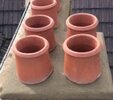Hi All
What's your take regarding installing cowl on chimney pots which are unused? I can't help thinking that when it rains heavily some water must go in the chimney and pool somewhere?
At the same time I see a lot of pots which don't and there are no damp issue.
In your experience what are the pros and cons of installing cowls on unused chimney pots?
What's your take regarding installing cowl on chimney pots which are unused? I can't help thinking that when it rains heavily some water must go in the chimney and pool somewhere?
At the same time I see a lot of pots which don't and there are no damp issue.
In your experience what are the pros and cons of installing cowls on unused chimney pots?


